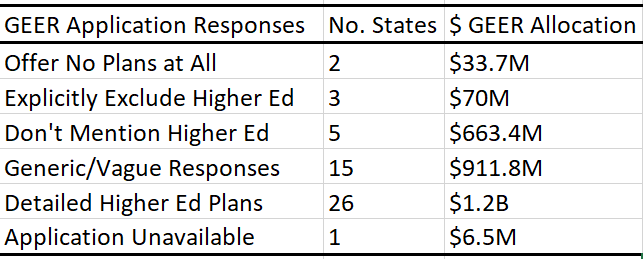Last week, @usedgov posted states’ applications for the Governor’s Emergency Education Relief (GEER) Fund. I analyzed the text to learn about governors’ priorities for higher education spending. A thread on key insights 1/ https://oese.ed.gov/offices/education-stabilization-fund/governors-emergency-education-relief-fund/geer-certifications-agreements/">https://oese.ed.gov/offices/e...
Background: GEER is a $3B fund from the total $30B for education from the CARES Act. Governors are supposed to spend this on the schools and colleges “most significantly impacted by #COVID-19” so they can “continue to provide educational services.” 2/
The Dept created an app/agreement form, asking questions about whether “a state intends to use the award, or a portion of the award, to establish, develop, improve, or expand the availability, accessibility, capacity, and use of remote learning techniques and technologies.” 3/
Some states answered the questions thoroughly, providing detailed plans for the funds. Others did not, offering general statements about using the funds to support students, employees, & institutions. Regardless of quality, all awards were made. My summary of their responses: 4/
The most egregious apps were from Vermont & Utah, both saying they would not use the GEER Funds for the purposes implied in the questions & did not offer explanations for what they would do. They still got their funds, $4.5 million & $29.2 million, respectively. Here& #39;s Utah: 5/
The District of Columbia, Puerto Rico, and Nebraska specifically stated they would not use their GEER funding for higher education institutions. Their combined $70M will go to K-12. 6/
Five other states (CA, DE, MI NY, WI) made no mention of higher ed in their applications, implying a sole focus on K-12 spending. The higher ed institutions in these states will apparently lose out on their share of a combined $663.4M in aid. 7/
Fifteen states wrote responses that were too vague, too short, or too generalized across K-12 and higher ed to pull out specific funding targets for higher education. Example: Alabama 8/
The remaining 26 states completed the application more thoroughly, such that they named specific targets for #highered. Some offered lengthy, detailed proposals. There were 6 major themes on how governors want to spend their GEER funds on higher education. 9/
1. 23 states made proposals about remote learning, including improving course delivery software, developing new curricula for online delivery, creating online repositories for best practices and existing courses, and others. 10/
2. Noting the large digital divide, 16 states will invest in hardware (mostly laptops) and/or internet access (WiFi hotspots) for their college students. 11/
3. 12 states will provide professional development training to faculty on how to teach online. 12/
4. To ensure students continue to enroll, persist, and graduate, 9 states will spend some of the funds on bolstering student services at colleges, like academic advising and other “wraparound” services. 13/
5. Though institutions already received CARES Act funds for emergency student aid, 7 states indicated they would disburse GEER funds directly to students as additional financial aid. 14/
6. Five states highlighted the economic upheavals of the coronavirus pandemic on workers and will use GEER funds to support workforce development and/or adult education. 15/
There are also miscellaneous proposals. TX wants to build institutional data analytics infrastructure and Kansas will purchase cleaning supplies, for example. 16/
States have 45 days from their award date to submit an “initial report” on their process for distributing GEER funds. Some are due by now, more are due over the next month. None are posted on the website yet. 17/ https://oese.ed.gov/offices/education-stabilization-fund/governors-emergency-education-relief-fund/geer-certifications-agreements/">https://oese.ed.gov/offices/e...
How exactly states will spend their GEER funds is yet to be seen. Some states have made announcements about their intentions, which may or may not match exactly what they proposed in their applications. @Hunt_Institute is tracking those statements. 18/ http://www.hunt-institute.org/covid-19-resources/geer-fund-utilization/">https://www.hunt-institute.org/covid-19-...
NOTE: The allocation values on the @usedgov website are incorrect for every state starting with Puerto Rico. Puerto Rico should be last in the table with $47.8 million. Instead, it’s in Rhode Island’s spot with $8.7 million, which throws off the rest of the table. 19/
Will update this thread with relevant news, including when ED posts the "initial reports." 20/

 Read on Twitter
Read on Twitter






